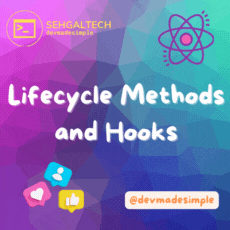
Welcome back to the React 101 series! In this edition, we’ll learn about how to fetch data from APIs and manage data flow within your React applications. Connecting to APIs, retrieving data, and efficiently handling its flow are integral aspects of creating dynamic and responsive web applications. Let’s explore the best practices and tools to seamlessly integrate external APIs into your React projects.
The Importance of Data Fetching in React
In modern web development, applications often rely on external APIs to fetch and update data dynamically. Whether it’s retrieving information from a server, updating user interfaces in real-time, or interacting with third-party services, effective data management is crucial for building robust and interactive React applications.
Why Fetch Data?
Imagine a static React app, like a photograph, beautiful but unchanging. To truly engage users, your app needs dynamic content, which often comes from APIs (Application Programming Interfaces) that provide data access. Fetching data allows you to:
- Display real-time information: Show live news feeds, weather updates, or stock prices.
- Present user-specific data: Personalize experiences by displaying user profiles, preferences, or purchase history.
- Enable interactive features: Build features like search functionality or e-commerce applications.
Fetching Data Techniques:
There are two main approaches to fetching data in React:
1. Class Components & Lifecycle Methods:
componentDidMount: Use this lifecycle method to fetch data once the component mounts.fetchAPI: This built-in browser API allows you to make HTTP requests to retrieve data.
2. Functional Components & Hooks:
useState: Manage the state of your component, holding the fetched data.useEffect: Similar tocomponentDidMount, this hook performs side effects like fetching data, but with more flexibility.axios(recommended): A popular external library offering a more user-friendly way to make HTTP requests and handle responses.
Utilizing fetch for API Requests
The fetch API is a powerful and native JavaScript method for making network requests. It’s commonly used to fetch data from APIs in React applications. Here’s a basic example of using fetch to retrieve data:
import React, { useState, useEffect } from 'react';
const DataFetchingComponent = () => {
const [data, setData] = useState(null);
useEffect(() => {
const fetchData = async () => {
try {
const response = await fetch('https://api.example.com/data');
const result = await response.json();
setData(result);
} catch (error) {
console.error('Error fetching data:', error);
}
};
fetchData();
}, []); // Empty dependency array ensures the effect runs only once on component mount
return (
<div>
{data ? (
<ul>
{data.map((item) => (
<li key={item.id}>{item.name}</li>
))}
</ul>
) : (
<p>Loading data...</p>
)}
</div>
);
};
export default DataFetchingComponent;
In this example, the component fetches data when it mounts and updates its state with the retrieved information. The loading state is displayed while waiting for the API response.
Utilizing Axios for API Requests
Axios is a popular JavaScript library for making HTTP requests, and it’s widely used for API requests in React applications. Here’s an example of how you can utilize Axios for API requests in a React component:
First, you need to install Axios:
npm install axios
Then, you can use it in your React component:
import React, { useState, useEffect } from 'react';
import axios from 'axios';
const DataFetchingComponent = () => {
const [data, setData] = useState(null);
const [loading, setLoading] = useState(true);
useEffect(() => {
const fetchData = async () => {
try {
const response = await axios.get('https://api.example.com/data');
setData(response.data);
} catch (error) {
console.error('Error fetching data:', error);
} finally {
setLoading(false);
}
};
fetchData();
}, []); // Empty dependency array ensures the effect runs only once on component mount
return (
<div>
{loading ? (
<p>Loading data...</p>
) : (
<ul>
{data.map((item) => (
<li key={item.id}>{item.name}</li>
))}
</ul>
)}
</div>
);
};
export default DataFetchingComponent;
In this example:
- The
useEffecthook triggers the data fetching when the component mounts. - Axios is used to make a GET request to the specified API endpoint.
- The fetched data is set to the component’s state using
setData. - The loading state is managed with the
setLoadingfunction to display a loading message while waiting for the API response.
Using State Management Libraries
As your application grows in complexity, managing state and data flow becomes more challenging. Libraries like Redux or the Context API can help centralize state management and simplify the flow of data across components.
Integrating Redux
Redux is a popular state management library for React applications. It provides a centralized store to manage the application state, making it easy to fetch and update data.
1. Install Redux:
npm install redux react-redux
2. Set Up Actions, Reducers, and Store:Create actions to define the types of data fetching operations, reducers to handle state changes, and a store to bring everything together.
3. Connect Components:Use the connect function from react-redux to connect your components to the Redux store.
Leveraging Context API
The Context API is a built-in React feature that enables components to share state without having to pass props through every level of the component tree.
1. Create Context:
// DataContext.js
import { createContext } from 'react';
const DataContext = createContext();
export default DataContext;
2. Wrap Components:
Wrap your components with the DataProvider to provide the shared state.
// App.js
import React from 'react';
import DataProvider from './DataContext';
import DataFetchingComponent from './DataFetchingComponent';
const App = () => {
return (
<DataProvider>
<DataFetchingComponent />
</DataProvider>
);
};
export default App;
3. Access Context:
Consume the shared state within your components using the useContext hook.
// DataFetchingComponent.js
import React, { useContext } from 'react';
import DataContext from './DataContext';
const DataFetchingComponent = () => {
const { data, loading, fetchData } = useContext(DataContext);
// Component logic
};
export default DataFetchingComponent;
Beyond the Basics:
- Error handling: Implement robust error handling to gracefully handle situations where data fetching fails.
- Loading state: Display a loading indicator while data is being fetched to improve user experience.
- Data caching: Strategically cache fetched data to improve performance and reduce API calls.
Remember:
- Choose the right approach: Select the data fetching method and state management strategy that best suits your application’s complexity.
- Plan your data flow: Clearly define how data will be fetched, stored, and passed between components.
- Practice makes perfect: Experiment with different techniques and libraries to solidify your understanding.
Conclusion
Data fetching and management are essential skills for React developers building modern, interactive applications. Whether you’re fetching data from APIs using the fetch API or implementing advanced state management with libraries like Redux or the Context API, understanding how to handle data flow in React is crucial. Stay tuned for more React insights in our React 101 series!





